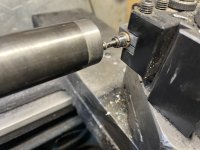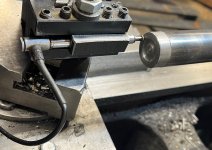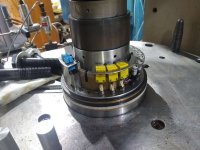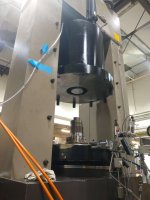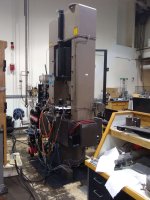dgfoster
Diamond
- Joined
- Jun 14, 2008
- Location
- Bellingham, WA
Baja,
And I agree that your suggestion that the actual full-sized model should be tested as measuring one element of a system while ignoring other elements can have some unexpected outcomes.
But, in designing this piece I had to start somewhere and at least get a real-world-based sense of whether the design could be reasonably expected to work well as envisioned or should I modify it from the get-go due to stability concerns. I think the far from ”proven” observations suggest it is reasonable to proceed with the design as previously shown. ( I am continuing to make relatively minor aesthetic changes as personal taste dictates.).
I do intend to eventually set up a machined full-sized part and see if it is stable enough (see Memphisjed’s post) for day-to-day use as previously outlined. That will be the final arbiter—-real world, reasonably well described, and reasonably instrumented bench testing.
Denis
Baka, I completely agree with everything you said. I am relieved that the tone of my last post did not cause some unfortunate dust-up.I hear what you are saying and agree on unnecessary overdesign or overspecification, but the points I was trying to make were:
I don't think I'm advocating anything extreme here, I get that you are saying you want to see evidence before taking any of these actions, I agree about wanting evidence, but in absence of it, conservatism seems wiser. Maybe you're right that in normal use this won't matter, I don't think the experiment above is proof enough, maybe we disagree on that. But if a manufacturer is going to pursue aesthetic design of a reference instrument (a worthy goal) over more simplistic or proven alternatives, I suggest they have some duty to know that it won't compromise the function. The actual device in question has a lot going on and may react unexpectedly or unintuitively. Testing with an actual casting, or the 1/2 sized prototype unit would likely provide better answers, and I think everyone will be pleased if it is proven to be stable even when handled without so much concern.
- When you can easily insulate the gripping surface of such a tool, it seems like cheap insurance to do so.
- Even if the movement is tiny, it could still potentially have a non-linear influence on the curvature of a reference surface.
- Large differences in surface area and cross section in sub structures of a design are going to make it more sensitive to thermal disparities.
And I agree that your suggestion that the actual full-sized model should be tested as measuring one element of a system while ignoring other elements can have some unexpected outcomes.
But, in designing this piece I had to start somewhere and at least get a real-world-based sense of whether the design could be reasonably expected to work well as envisioned or should I modify it from the get-go due to stability concerns. I think the far from ”proven” observations suggest it is reasonable to proceed with the design as previously shown. ( I am continuing to make relatively minor aesthetic changes as personal taste dictates.).
I do intend to eventually set up a machined full-sized part and see if it is stable enough (see Memphisjed’s post) for day-to-day use as previously outlined. That will be the final arbiter—-real world, reasonably well described, and reasonably instrumented bench testing.
Denis
Last edited:





